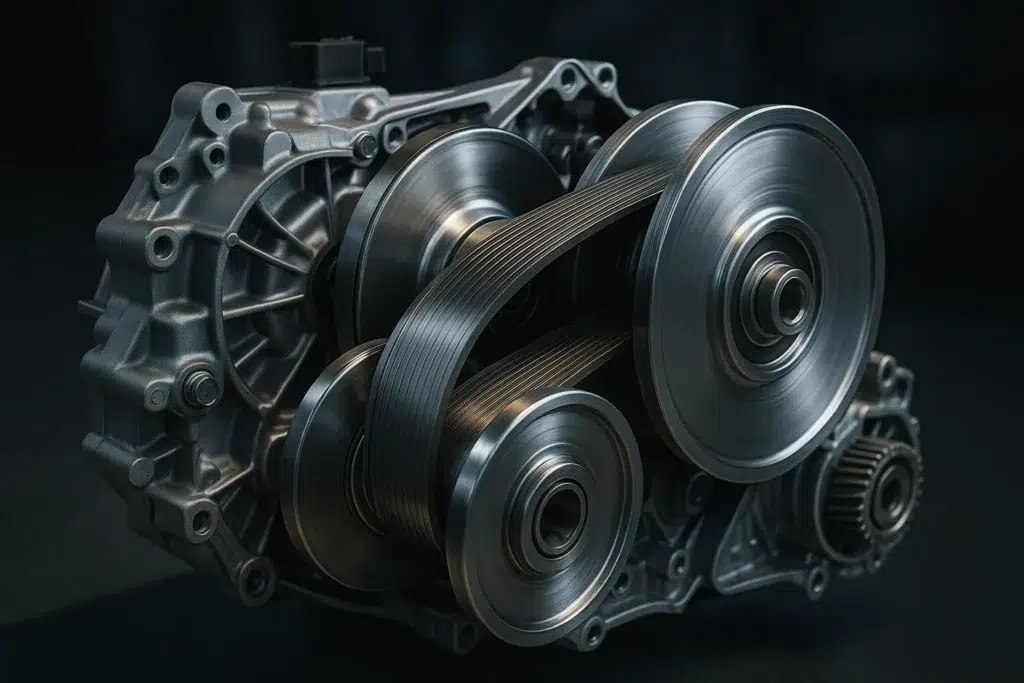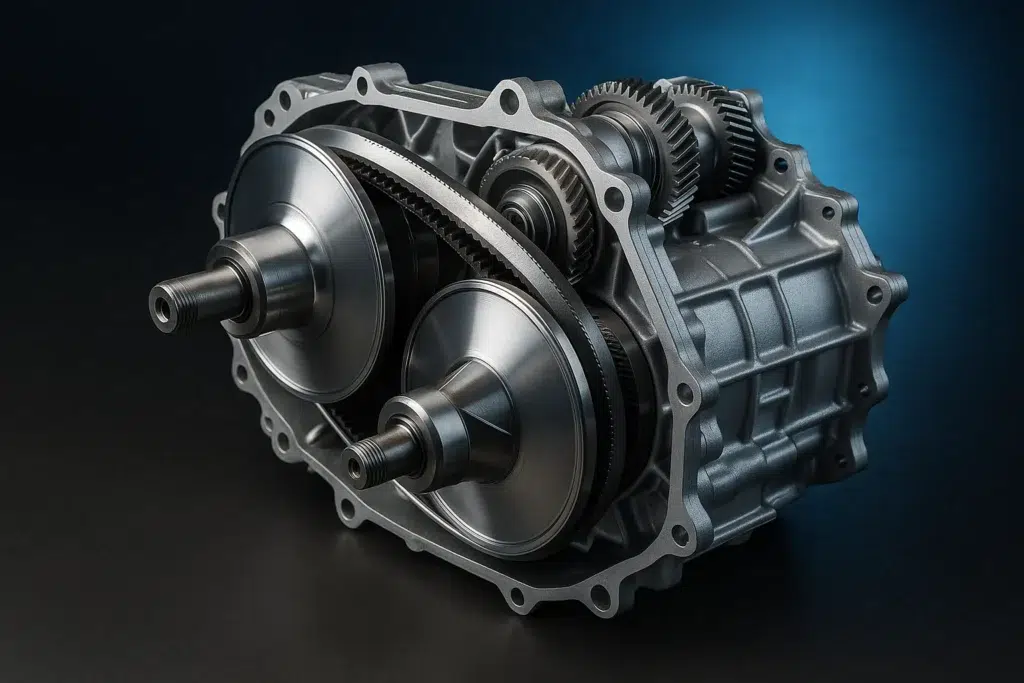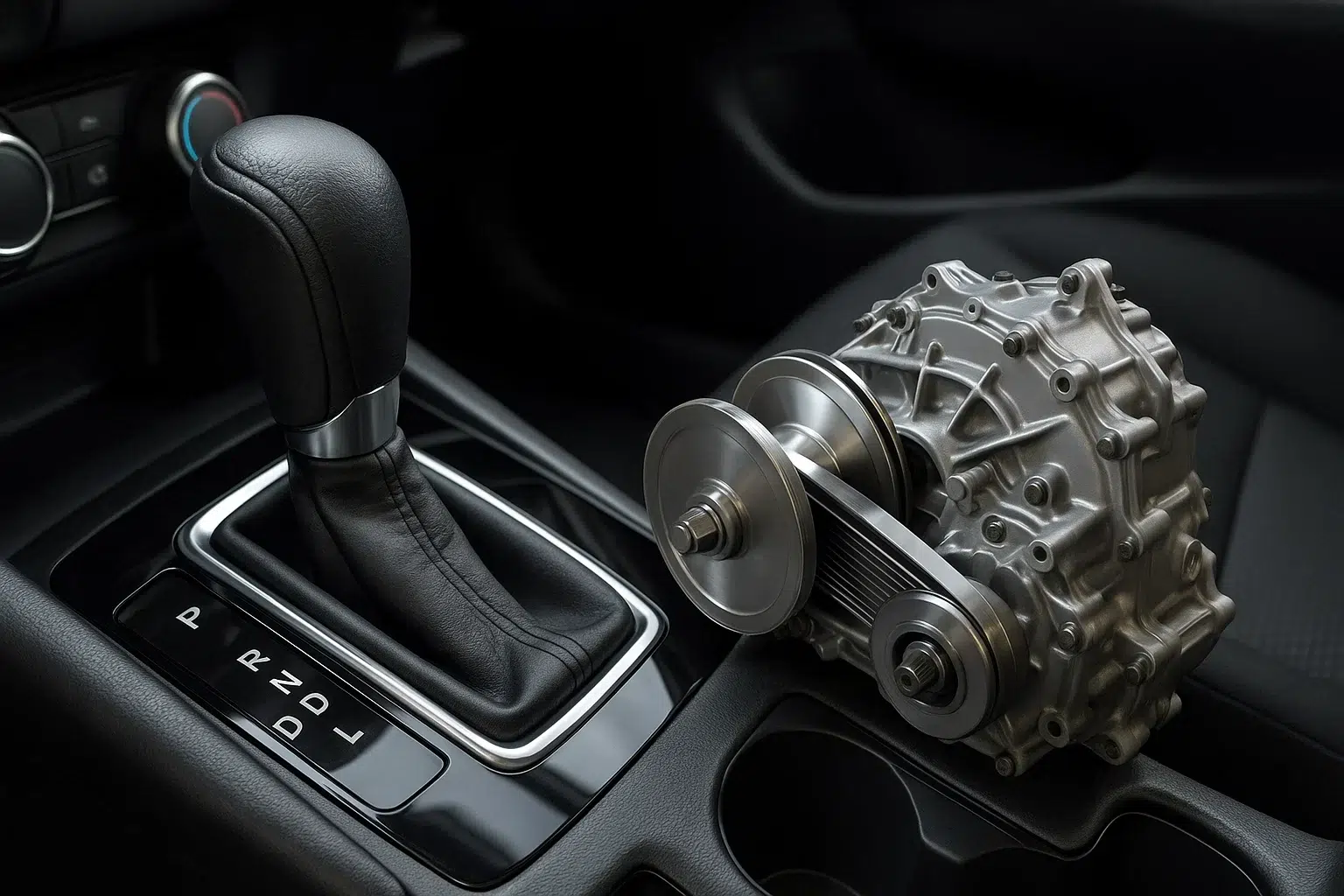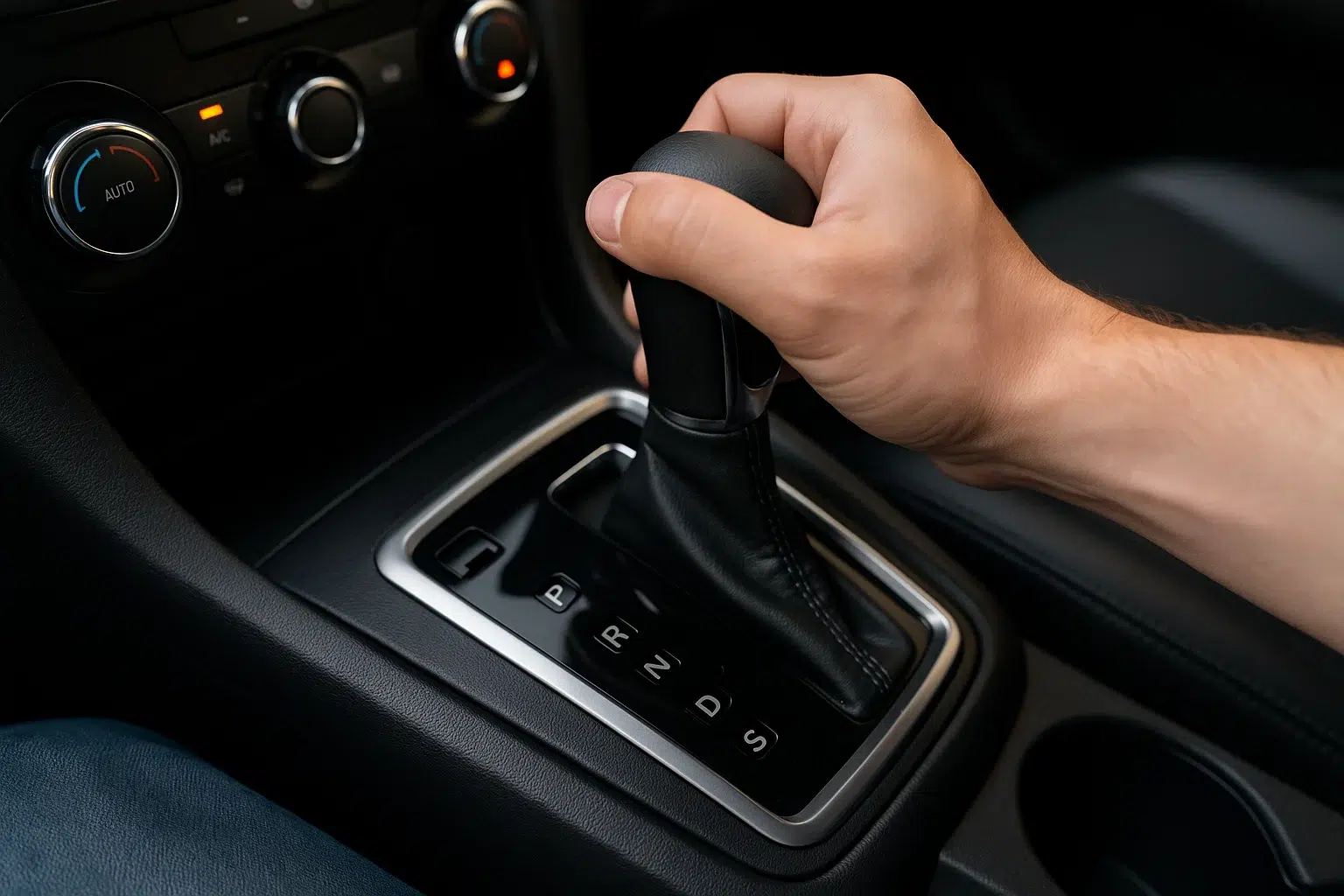Manual and automatic gearboxes are changing differently. The Continuously Variable Transmission, or CVT, is one of the most advanced technologies in the market. Unlike fixed-gear transmissions, the CVT provides an uninterrupted driving experience by optimally adjusting the gear ratio based on real-time driving conditions. CVT transmissions seamlessly improve an automobile’s fuel economy, comfort, and performance.
In this article, we will explain the concept of CVT, how it functions, its advantages and disadvantages, various types, and their maintenance tips. This guide is for everyone, from people planning on buying continuously variable transmission cars to those simply curious about the topic.
What is a Continuously Variable Transmission (CVT)?
A Continuously Variable Transmission is one more automatic transmission type that smoothly changes higher or lower gears without suspending power delivery. CVTs use belt and pulley systems instead of fixed gears to more smoothly adjust power delivery.
CVTs often power passenger cars with increased fuel efficiency, and improve drivability, which is smoother and more seamlessly. With CVTs, engines maintain optimal RPMs at a given speed.
Unlike an automatic transmission car with 1st, 2nd, or 3rd gears, CVT have a continuously adaptable range of ratios.
Working of a CVT
Most CVT designs utilize a belt-and-pulley system:
- Primary Pulley (Drive Pulley) – It is connected to the engine and changes width to increase or decrease the position of the belt.
- Secondary Pulley (Driven Pulley) – Connected to the wheels, it also modifies width to change the gear ratio.
- High-Strength Belt or Chain – Transfers the power between the pulleys.
Smooth acceleration occurs due to the reason the pulleys gradually increase and decrease their diameters which allow the belt to rest lower on one and higher on another pulley. This gives a smooth increase in gear ratio without any shifting.
Example: While driving in the city the CVT will minimize the engine RPM to conserve fuel. While CVT adjusts engine RPM, it allows the engine to quickly get to optimum power for acceleration during overtaking.
Advantages of a CVT
- Seamless Driving Experience – Perfect for city traffic and commuting, there are no jerked shifts in gears.
- Improved Fuel Economy – Keeps the engine within the most productive RPM range.
- Enhanced Acceleration – No downshifting is needed for moving to the next gear and power is instant.
- Reduced Weight – Typically improves performance when compared to older automatics which are heavier in weight.
- Emission Reductions – Fuel efficiency as well as emissions are improved with optimized RPM.
Some cars with adaptive cruise control use CVT to further the driving experience comfort, particularly for highway travel.
Disadvantages of a CVT
Along with advantages, a CVT comes with the following disadvantages:
- Changes in Driving Feeling – Drivers accustomed to changes in gear may find a constant RPM, unusual.
- Worries About Durability – CVT belts can be a problem from a durability standpoint if not serviced regularly.
- Reduced Capacity for Towing – Compared to some automatic transmissions, CVTs are not heavy-duty towing efficient.
- Costs of Repair – CVTs can have expensive repair and replacement components.
Types of Continuously Variable Transmissions

- Belt-and-Pulley CVT – Most commonly used in regular cars.
- Toroidal CVT – Different than other CVTs since it uses rotating discs and rollers instead of belts.
- Hydrostatic CVT – Uses hydraulic pumps and motors and is common in heavy machinery.
- Cone CVT – Uses conical pulleys to change gears.
Some manufacturers change CVTs to mimic gears for a more sporty feel when driving.
CVT vs. Automatic Transmission vs. Manual
| Feature | CVT | Automatic Transmission | Manual |
| Gear Ratios | Infinite | Fixed (4-10) | Fixed (5-7) |
| Smoothness | Very High | Moderate | Low |
| Fuel Efficiency | High | Moderate | Varies |
| Driving Engagement | Low | Moderate | High |
| Maintenance Cost | Medium | Medium-High | Low |
Fuel efficiency and comfort are key priorities for many drivers, making the CVT-equipped Automatic Transmission cars a popular choice.
Maintenance Tips for CVT Cars
To keep your CVT in good condition:
- Check the fluid levels frequently – CVT fluid, unlike automatic transmission fluid, should be checked and replaced according to the manufacturer’s specified schedule.
- Avoid Overloading – Prevents accelerated deterioration of the belt.
- Gentle Accelerating – Lessens stress on the transmission.
- Servicing as per schedule – Professional inspections managed on a schedule assist with calendar-based troubleshooting for early detection.
Common Problems With A CVT And How To Fix Them
A CVT can run into problems such as:
- Slipping or Hesitation – Commonly mistakes made from low or dirty fluids.
- Unusual Noises – Result from worn pulleys and belt difficulties.
- CVT Heating – Caused by excessive workloads or extended periods of driving at high speeds.
Some symptoms might be indistinguishable from other problems, such as your car heater not working or other components failing. Correct diagnosis is essential.
CVTs in Different Car Categories
- Small Cars – Best suited to navigate through the city traffic due to CVT’s fuel efficiency.
- SUVs – Some models fitted with CVTs have enhanced torque performance.
- Hybrids – CVTs are frequently combined with electric motors for ultra-smooth operation.
A used car mileage often plays a role in a CVT’s condition, especially with older models where high mileage CVTs without proper maintenance can shorten lifespan.
Driving Tips for CVT Cars
- Use cruise control in cars during long trips for better fuel economy.
- Avoid rapid changes to the accelerator, unless there is a compelling reason to perform so.
- Do not coast downhill in neutral as this hampers engine lubrication.
CVT and Performance Cars
While emphasizing fuel efficiency, CVTs can be found in some performance cars and in some types of motorsports, including rally racing. With refinement, some rival the performance of Automatic car clutch systems due to rapid responsiveness and smooth delivery of power.
CVT Technology Innovations

Continuously Variable Transmission (CVT) is constantly being innovated by its manufacturers:
- Simulated Gear Steps – Functions like a conventional automatic gearbox while maintaining CVT efficiency.
- Stronger Belts – For higher powered engines.
- Adaptive Control Systems – Changes CVT behavior depending on driving style.
Some advanced car steering wheel controls provide manual “gear” selection in CVTs.
CVT and Emissions
CVTs assist in eliminating emissions by maintaining the engine’s optimal efficiency. This is critically important in achieving international standards for the environment, in addition to improving the vehicle’s economy.
If your vehicle exhibits abnormal symptoms such as a gas smell from exhaust, the issue is CVT-unrelated but may still impact overall vehicle performance.
When to Replace CVT Fluid
Adhering to a manufacturer’s service calendar is an absolute must. Failing to change transmission fluids may result in severe complications, like an oil leak after oil change if neglected.
Signs of CVT Failure
- Continuous whining sound
- Delayed acceleration
- Dashboard warning lights
- Jumpy or sliding movement
Excessive CVT problems could also result in car smoking, indicating overheating or damage to internal parts.
Buying a CVT Car – Things to Consider
- Test Drive – Ensure comfort with the distinct driving experience.
- Check Maintenance Records – Pay attention to regular servicing of changing fluids.
- Research Reliability – Some brands are known to have CVT systems that are more durable than others.
- Look at a comparison with Dual Clutch Transmission – They both have their pros and cons, but a dual clutch transmission could provide better performance and efficiency.
Conclusion
The Continuously Variable Transmission, or CVT, is a new invention in the automobile industry, providing a comfortable, smooth, and effective driving experience. continuously variable transmission cars are great for commuting, long trips, or even for fuel-efficient hybrids.
Like any new technology, a CVT has certain servicing requirements and driving guidelines that need to be followed in order to extend its lifespan. Knowing its advantages and disadvantages, along with its other features, can help in making a decision to purchase or maintain a CVT-based vehicle.

I am Tushar Balchandani, founder of Car Info Expert and someone who has been working extensively in the car industry as a car expert for 15 years. My aim is to provide useful truthful and reliable information to the readers based on my real experiences and hands-on experience. From buying tips to maintenance guides, I help readers make confident car-related decisions.




